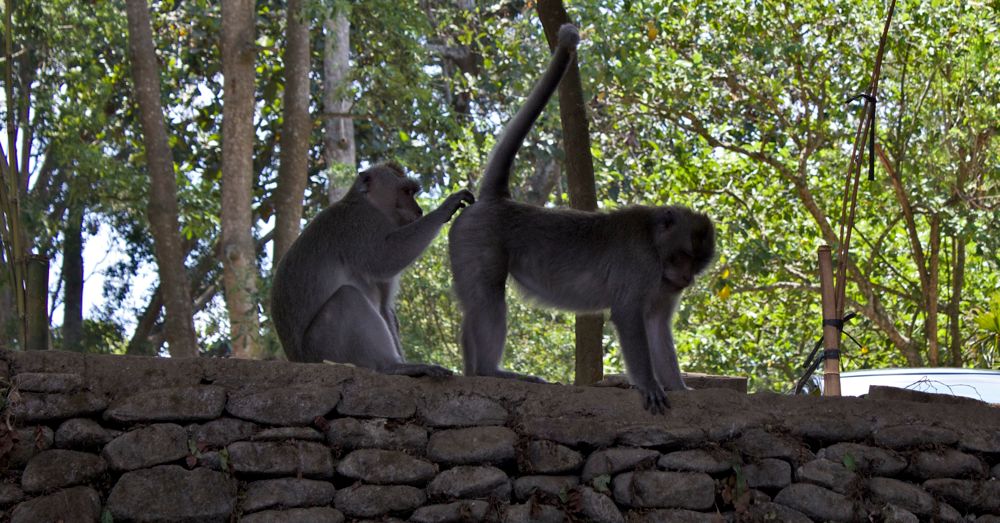Tuesday 4-11-2014. Day 76.
Good vs Evil, Silver vs Wood, Man vs Monkey
We'd done absolutely nothing for three days and spent another day making chocolate elephants, so we decided it was time to see some more of what Bali had to offer.
Our driver offers a number of different tours of the area, so we picked the “Ubud Surrounding Tour” which showcased some of the attractions in the greater Ubud area. The day started at 9:00 a.m. when he picked us up and took us to see the Barong Dance.
Barong Dance
Barong is a lion like creature who leads the forces of good in the daily struggle against evil. His opposite number is a terrifying, dark magic-practicing old woman named Rangda, who is depicted with long raggedy hair, razor-sharp nails, and saggy breasts. She has at her command an army of demons.
The dance tells the story of good vs evil, Barong's first (maybe?) battle with Rangda. The action of the story was a little hard to follow, mainly because we weren't entirely sure who all the principal, non-deity players were, but during the climactic fight, the good warriors were ensorcelled by Rangda to stab themselves with their own poisoned kris (Indonesian daggers), but Barong protected them by making their skin hard enough to resist the weapons. In the end Barong defeated Rangdha (if only until next time).
I tried looking up the full story of the dance we saw to get the complete chronology of the tale, but there are many different versions of the legend. The description at the Bali Touring Barong Dance page seems to best describe the action of dance we saw, even though there are some differences.
Batik
It wasn't on our official agenda, but our driver asked us if we wanted to see batik being made. Since batik is one of those famous Indonesian things people talk about (and since we were driving right by a place that made and sold it), we said sure.
Batik is a traditional Balinese dyeing technique that uses wax to make intricate designs. We got the quick tutorial on how batik designs are created before being shuttled right into the store, where we discovered they'll batik anything, even slippers and neckties. They ask you to not take pictures in the store, so we didn't. But here's a picture of an Indonesian hand-weaving loom because it was there, just outside.
Silver and Gold Smithing
Next on the tour was the silver jewelry making operation at UC Silver. Even before we pulled into the driveway, we saw the giant pink building adorned with a lot of intricate statues and stone sculptures — butterflies, happy pigs on bicycles, gods and goddesses, frolicking young boys. I'm not sure what all that has to do with silver and gold, but I will tell you it's a crazy amount of statuary.
Upon arrival, we got the briefest of tours on how the silver jewelry is made (we saw no gold being made). Each person sits at a station and makes the same thing, over and over, all day. There are torches and soldering irons involved, so you might imagine this rooms might be really hot. It was.
After the pieces are made, they're taken over to the polishing shop right next door, which has a similar set up (not quite as hot, though).
Eventually, the pieces end up in the store. Again, no pictures were allowed here, so here's an image of the outside of the place instead.
Bali Zoo
This particular tour included a stop at the Bali Zoo, which we were sort of lukewarm on, but since we were close by, we reluctantly agreed to check it out. The zoo is expensive for Bali ($98 for our family of four). Their credit card machine was mysteriously broken, though, and we weren't carrying enough U.S. dollars or Indonesian rupiah (1.2 million) to pay the entrance fee.
Our driver offered to take us to an ATM to get the money and bring us back, but that seemed like a lot of runaround for something none of us was really interested in anyway. So we skipped the zoo. The girls, in particular, were more interested in the Monkey Forest. But we had one more stop to make before the monkeys.
Wood Carving
When we got out of the car, we were greeted by a guide, like any other place we'd been that sells the goods made by on-site artisans, but this gentleman turned out to be the most laconic tour guide ever. He told us how the wood is carved and what types of wood they use and where it comes from. He delivered all this in the most hurried yet uninteresting presentation that I can't recall the different types, other than there was one called Java wood.
One of the carvers was polishing the wood (I guess that would make him a polisher), so I asked what sort of polish they used. They mix shoe polish (color depending on the type of wood being polished) with petrol (gasoline). That certainly explained the sharp smell in the air and the sting in my eyes.
Then we were escorted into the shop, where there were all sorts of different things carved out of wood, some small and stacked on shelves, some large and taking up entire sections of the floor. Oh, and I know what you're thinking. Of course they had them. They've everywhere.
There were also matching nude male and female tables (reclining figures with glass table tops) and lots of boobs. There were also some really interesting puzzle boxes, chairs that looked like hands, tons of small wooden mice, and a number of Komodo dragons, one of which was pretty close to life-size. Much of the carving was very intricate.
Our handler didn't seem to care if we bought anything or not, so we left, got back in the car and headed off to the Monkey Forest.
Little did we know this would be one of the most terror-fraught moments of our entire trip.
Sacred Monkey Forest
The Sacred Monkey Forest of Padangtegal sits on the lower end of Ubud Village, down a road lined with many different statues of monkeys. It is, as the name suggests, filled with monkeys.
A selection of Monkey Statues
Scary monkey statue.
Creepy monkey statue.
Family monkey statue.
The monkeys in question are crab-eating macaques, and of the many things you need to know about them (besides being carriers of Hepatitis B), the most important is they want your stuff. One grabbed Jackie's colorful camera case and played a serious game of tug-or-war before it let go.
You don't need to enter the Monkey Forest to see these monkeys, though. There are always a few lounging about on the walls or the road that runs alongside the Monkey Forest (named, appropriately, Monkey Forest Road).
The forest has three different temples in it, so the place is sacred. Dogs aren't allowed inside, and the monkeys run wild. After paying the entrance fee (30,000 rupiah for adults, 20,000 for kids) and setting foot inside, a visitor is immediately accosted by a horde of the 600-something monkeys that live in the forest. The official name of a group of monkeys is a troop (or a barrel—really!), but when they're all coming at you, rushing out the trees and bounding down the paved walkway all you think is "Holy crap! A horde of monkeys!"
You can buy a large bunch of bananas for 50,000 rupiah or a small bunch for 20,000 rupiah to feed the monkeys. Once you have the bananas in your hands, though, look out, because these greedy little primates will be coming right for you.
You aren’t supposed to touch the monkeys, but they’re all about touching you — they run right up you if you’re holding food or they think you’re holding food.
If you have food and don't give it to them, it's not uncommon for them to bite you. We watched one monkey run up a man who had his young son strapped to his back. The monkey sat on the man's neck for an uncomfortable moment or two, then hissed at the small child and tried to bite the kid. The kid screamed. The dad swore (at least it sounded like swearing in German) and threw the monkey on the ground. It was pretty scary.
Wonderful little creatures, these monkeys.
They can be kind of creepy, but they can be pretty funny, too, like this guy that ran around with an empty water bottle in his mouth.
Or this guy that's clearly had a few too many bananas.
Samantha couldn't wait to get away from these unpredictable little primates, and after we escaped from the Monkey Forest (happy to have avoided monkey bites or scratches) we had a late lunch at a trendy but forgettable spot before heading back to the villa for some early evening swimming.
Read more about our Sacred Monkey Forest adventure in Mean Monkey Monday #13 for Boing Boing.
Notable Statistics
iPadographers: 2
Violent monkey encounters witnessed: 1
Hours in a car: 3

Tom Fassbender is a writer of things with a strong adventurous streak. He also drinks coffee.



























